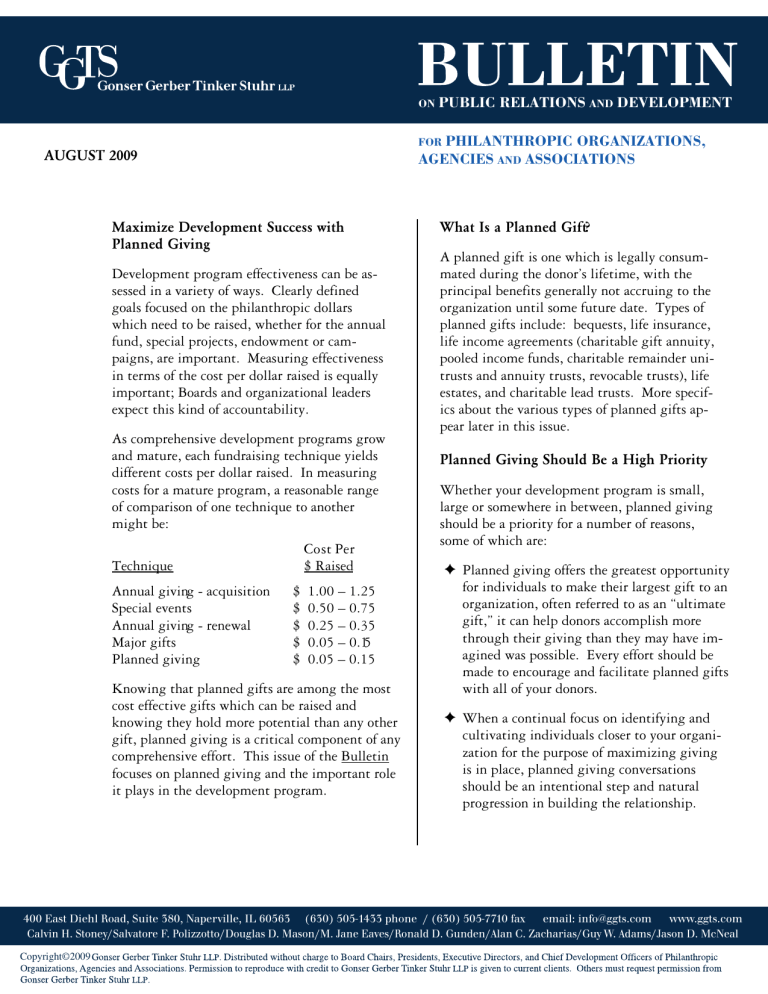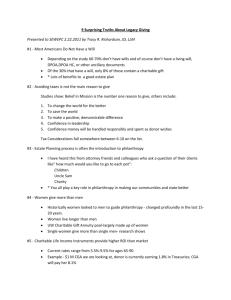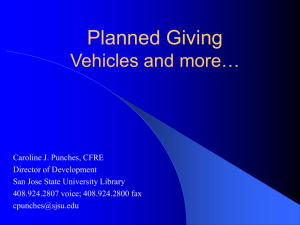A planned gift is one which is legally consum-

AUGUST 2009
Maximize Development Success with
Planned Giving
Development program effectiveness can be assessed in a variety of ways. Clearly defined goals focused on the philanthropic dollars which need to be raised, whether for the annual fund, special projects, endowment or campaigns, are important. Measuring effectiveness in terms of the cost per dollar raised is equally important; Boards and organizational leaders expect this kind of accountability.
As comprehensive development programs grow and mature, each fundraising technique yields different costs per dollar raised. In measuring costs for a mature program, a reasonable range of comparison of one technique to another might be:
Technique
Cost Per
$ Raised
Annual giving - acquisition $ 1.00 – 1.25
Special events
Annual giving - renewal
Major gifts
Planned giving
$ 0.50 – 0.75
$ 0.25 – 0.35
$ 0.05 – 0.15
$ 0.05 – 0.15
Knowing that planned gifts are among the most cost effective gifts which can be raised and knowing they hold more potential than any other gift, planned giving is a critical component of any comprehensive effort. This issue of the Bulletin focuses on planned giving and the important role it plays in the development program.
ON
PUBLIC RELATIONS
AND
DEVELOPMENT
FOR
PHILANTHROPIC ORGANIZATIONS,
AGENCIES
AND
ASSOCIATIONS
What Is a Planned Gift?
A planned gift is one which is legally consummated during the donor’s lifetime, with the principal benefits generally not accruing to the organization until some future date. Types of planned gifts include: bequests, life insurance, life income agreements (charitable gift annuity, pooled income funds, charitable remainder unitrusts and annuity trusts, revocable trusts), life estates, and charitable lead trusts. More specifics about the various types of planned gifts appear later in this issue.
Planned Giving Should Be a High Priority
Whether your development program is small, large or somewhere in between, planned giving should be a priority for a number of reasons, some of which are:
✦ Planned giving offers the greatest opportunity for individuals to make their largest gift to an organization, often referred to as an “ultimate gift,” it can help donors accomplish more through their giving than they may have imagined was possible. Every effort should be made to encourage and facilitate planned gifts with all of your donors.
✦ When a continual focus on identifying and cultivating individuals closer to your organization for the purpose of maximizing giving is in place, planned giving conversations should be an intentional step and natural progression in building the relationship.
400 East Diehl Road, Suite 380, Naperville, IL 60563 (630) 505-1433 phone / (630) 505-7710 fax email: info@ggts.com www.ggts.com
Calvin H. Stoney/Salvatore F. Polizzotto/Douglas D. Mason/M. Jane Eaves/Ronald D. Gunden/Alan C. Zacharias/Guy W. Adams/Jason D. McNeal
Copyright©2009
AUGUST 2009
!
As relationships with individuals grow stronger, it is imperative that conversations about planned giving and their estate plans take place. Planned giving discussions can help create deeper relationships with donors and build trust; discussions can help create higher expectations as to what individuals can and want to do for your organization.
!
While often seen as a “long-term” strategy with individuals, planned giving discussions can also positively impact short-term donor decisions about gifts to the annual fund, special initiatives, and campaigns.
!
Nothing builds long-term development program strength better than an intentional, consistent planned giving program. Also, during this time of economic uncertainty, individuals who may be reluctant to commit an outright major gift may be willing to consider a planned gift.
!
According to Giving USA 2009, total estimated giving for 2008 is $307.65 billion. Of this total, charitable bequests are estimated to be $22.66 billion or 7 percent.
!
Researchers John J. Havens and Paul G.
Schervish of the Boston College Social Welfare Research Institute published a report in
1991, Millionaires and the Millennium:
New Estimates of the Forthcoming Wealth
Transfer and the Prospects for a Golden Age of Philanthropy , which predicted that a 55year transfer of wealth that began in 1998 estimated to be $41 trillion, will produce at least
$6 trillion in charitable bequests. Although it is uncertain what impact the economic situation of the past year will have on those predictions, there is no doubt that charities will continue to benefit substantially from planned giving by individuals.
The Planned Giving Team
Members of the planned giving team generally include the Executive Director/CEO, Chief Development Officer, Planned Giving Officer, and
Major Gifts Officer, but can also include other development officers who have an external focus,
Page - 2 including those responsible for annual giving and alumni relations. In addition, key volunteers such as Board and advisory council members have an important role to play in planned giving.
The Executive Director/CEO and Chief Development Officer must build an appropriate budget to support the planned giving program, with support from the Board Development
Committee. The Chief Development Officer must make planned giving an integral part of the development program and realize its major gift potential. Staff members who work with major gifts must have a working knowledge of the various types of planned gifts available; they need to be able to recognize potential donors of planned gifts and refer them to staff members with specific planned giving expertise.
It is important that each member of the Board and the Board Development Committee take a lead role and advocate for the planned giving program. Each Board member should be asked to set an example by making a planned gift themselves. A Planned Giving Committee should be organized and composed of agents of wealth – trust officers, lawyers, accountants – who are able to give expert insights. They can also help in a variety of ways, including newsletter copy review, planned giving brochure development, with events focused on planned giving or with the planned giving program.
Promoting the Planned Giving Program
A planned giving program can only be as effective as its communications plan. Consider the following ways to build awareness among your targeted audience of individuals:
1.
A separate estate planning newsletter, published 3-4 times a year and distributed to targeted constituents (those at least in their 40’s).
2.
Include articles or advertisements in your magazine, newsletter, or other publications which stress the importance of both estate planning and remembering your organization in his/her will. Feature individuals who have made planned gifts in stories.
AUGUST 2009
3.
Seminars sponsored on the subject of estate planning.
4.
Create a recognition club for individuals who have indicated they have a planned gift commitment; publish the names in your annual report.
5.
Have regular meetings with agents of wealth; they are the experts and in a position to influence their clients.
6.
Develop brochures on specific planned giving instruments.
7.
Provide appropriate recognition, such as a donor wall and at special events.
8.
Include information in key publications; pledge forms and response devices for direct appeal materials should include a section which asks individuals if they have already included your organization in their estate planning or if they would like more information on the topic.
9.
Provide content on the development page of your organization’s website which includes general information of the various types of planned giving vehicles and contact information for appropriate organizational representatives.
Types of Planned Gifts
While the intention of this issue is not to provide specific information on planned giving vehicles, it is important to have a good basic understanding of various types of planned gifts, which include:
1.
Bequests – An outright gift through the will of a particular piece of property, a specific sum of money, or a designated share of such property.
2.
Life Income Agreements a.
Charitable Gift Annuity – A transfer of money or property to an organization in return for an agreement by the organization to pay the designated annuitant (or annuitants) a fixed income for life.
Page - 3 b.
Deferred Payment Gift Annuity – Similar to a regular charitable gift annuity, this plan enables the donor to establish a gift annuity today and defer the beginning date for receiving annual annuity income. This plan works best with high income donors who are still employed. c.
Pooled Income Funds – A donor irrevocably transfers money, securities or both to an organization to a separately maintained pooled income fund where it is invested, together with transfers of others who make similar gifts. The beneficiaries receive a proportional share of the pooled income fund earnings during their lifetime; at the donor’s death payments terminate and the organization removes the donor’s gift from the pooled fund and uses it for its established purposes. d.
Unitrusts – The Charitable Remainder Unitrust is a life income trust which specifies that the donor is to receive each year either the net income or a fixed percentage of the net fair market value of the trust assets valued each year. The fixed percentage must not be less than 5 percent. e.
Annuity Trusts – The Charitable Remainder
Annuity Trust is a life income trust which specifies that the donor (or other designated beneficiary) receive annually a fixed dollar amount which must be at least 5 percent of the initial net fair market value of the transferred property. There is not an annual valuation as with the unitrust. No additional contributions may be made to an annuity trust. f.
Revocable Trusts – A Revocable Charitable
Remainder Trust is similar to the previously described charitable remainder trusts, the principal difference being that the donor may revoke the trust at any time. Revocable trusts are appropriate for donors who would like to make a gift upon their death, but do not wish to make an irrevocable gift during their lifetime. A reason frequently stated for this is the concern the donor may have that the trust assets may be needed by the donor for some unforeseen emergency. The donor would earn no income tax deduction, but his/her estate would receive an estate tax deduction.
AUGUST 2009
3.
Life Insurance – Guarantees the payment of a fixed sum of money at a particular time.
Most cash-value policies a person owns represent an asset which may be used for charitable gift purposes. Gifts of life insurance can be made with presently owned policies which are no longer needed for family protection or with new policies.
4.
Life Estates – A Life Estate is a gift of one’s personal residence or farm to an organization while retaining the right to live on the property. Income, gift and estate tax benefits accrue to the donor from such a gift, assuming the gift is irrevocable.
5.
Charitable Lead Trusts – The Charitable
Lead Trust is a gift of income – and is the
“opposite” of the unitrust and annuity trust.
A Charitable Lead Trust is established by a donor transferring property to a trust, specifying that an organization will receive the income for a period of years or for the life or lives of an individual or individuals. The remainder interest is either retained by the donor or given to a non-charitable beneficiary (usually a family member).
Such a trust may provide an income tax charitable deduction for the donor, in which case the donor is deemed the owner of the income interest with trust income taxed to the donor.
Page - 4
On the other hand, the donor may establish the trust so that trust income is not taxed to the donor, in which case there is no income tax charitable deduction. The former is called a “qualified” charitable lead trust, the latter a
“non-qualified” charitable lead trust. A qualified charitable lead trust must follow the guidelines for the unitrust or annuity trust.
Conclusion
The word philanthropy comes from the Latin, philanthropia , which according to the Encarta®
World English Dictionary, in part means, “ general love for, or benevolence toward, the whole of humankind .”
In the work of development, nothing is more personal than talking with individuals about achieving their philanthropic goals and dreams through planned giving. Planned giving work cannot be done effectively unless it becomes personal. The point is, if you want to have an effective planned giving program, be prepared to get personal with your donors.
There is no better time than now to review your planned giving program and the opportunities which may exist with an intentional effort.
Making the area of planned giving a priority for your development program today will pay longterm dividends and could also positively impact other areas of giving by drawing individuals closer to your organization.
Gonser Gerber Tinker Stuhr LLP is a consulting firm dedicated to helping educational, healthcare, religious, human service, cultural, and other not-for-profit organizations clarify their aims, build their leadership and attract the human and financial resources they need to achieve their highest destiny.




